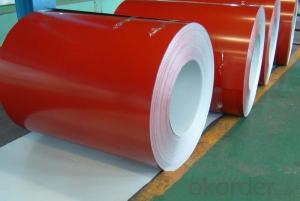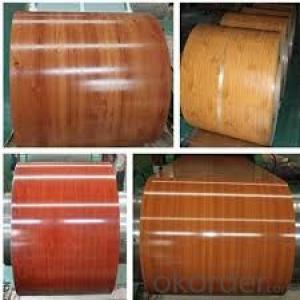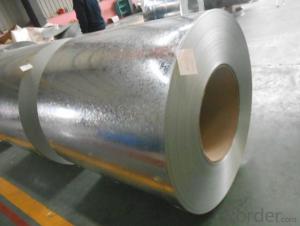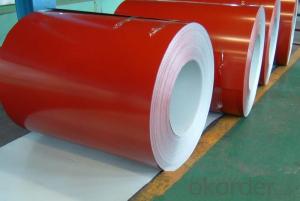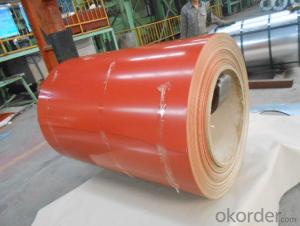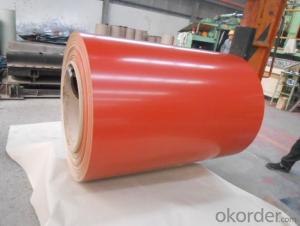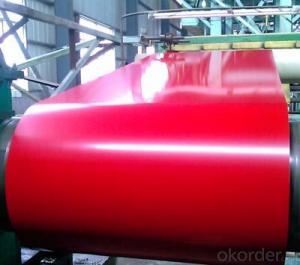Pre-Painted Galvanized/Aluzinc Steel Sheet in Coils Red Color with Good Quality
- Loading Port:
- Shanghai
- Payment Terms:
- TT OR LC
- Min Order Qty:
- 100 m.t.
- Supply Capability:
- 10000 m.t./month
OKorder Service Pledge
OKorder Financial Service
You Might Also Like
1. Pre-Painted Galvanized/Aluzinc Steel Coil Description:
With GI as base material, after pretreatment (degrease and chemical treatment ) and liquid dope with several layers of color, then after firing and cooling, finally the plate steel is called pre-painted galvanized (aluzinc) steel. Pre-painted galvanized steel is good capable of decoration, molding, corrosion resistance. It generally displays superior workability, durability and weather resistance.
2.Main Features of the Pre-Painted Galvanized/Aluzinc Steel Coil:
• Excellent process capability
• Smooth and flat surface
• Workability, durability
• Excellent heat resistance performance
• High strength
• Good formability
• Good visual effect
3.Pre-Painted Galvanized/Aluzinc Steel Coil Images
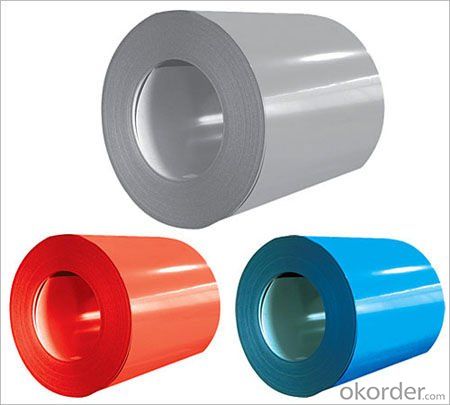
4.Pre-Painted Galvanized/Aluzinc Steel Coil Specification
Standard: AISI, ASTM, BS, DIN, GB, JIS
Grade: DX51D, DX52D
Thickness: 0.17-2.0mm
Brand Name: KMRLON
Model Number: coil
Type: Steel Coil
Technique: Cold Rolled
Surface Treatment: Coated
Application: Boiler Plate
Special Use: High-strength Steel Plate
Width: 20-1250mm
Length: customized
commoidty: pre-painted galvanized steel coil
Thickness: 0.13-4.0mm
width: 20-1250mm
zinc coating: 40-180g/m2
printing thickness: top side: 20+/-5 microns, back side: 5-7 microns
color: RED color
surface treatment: color coated
coil weight: 4-7 tons
coil ID: 508/610mm
packaging: standard seaworthy packing
5.FAQ of Pre-Painted Galvanized/Aluzinc Steel Coil
1. What’s the application of this product?
Roof, roof structure, surface sheet of balcony, frame of window, etc.
2. What’s the brand of the paint?
We use the best brand of all of the word—AKZO.
3. How about your company?
A world class manufacturer & supplier of castings forging in carbon steel and alloy steel,is one of the large-scale professional investment casting production bases in China,consisting of both casting foundry forging and machining factory. Annually more than 8000 tons Precision casting and forging parts are exported to markets in Europe,America and Japan. OEM casting and forging service available according to customer’s requirements.
4. How to guarantee the quality of the products?
We have established the international advanced quality management system,every link from raw material to final product we have strict quality test;We resolutely put an end to unqualified products flowing into the market. At the same time, we will provide necessary follow-up service assurance.
5. How long can we receive the product after purchase?
Usually within thirty working days after receiving buyer’s advance payment or LC. We will arrange the factory manufacturing as soon as possible. The cargo readiness usually takes 15-25 days, but the shipment will depend on the vessel situation.
- Q: How are steel coils processed for slitting or edge trimming?
- Steel coils are processed for slitting or edge trimming by feeding the coil into a slitting or trimming machine. The machine uses sharp rotating blades to cut the coil into smaller strips or remove the excess material from the edges. This process helps to create narrower coils or achieve precise edge dimensions for various applications.
- Q: This problem has puzzled me for a long time i always think about why stranded people on islands cant make a proper civilization and i always think it comes down to the ability to work metal. But its not like they could make a steel smelter/furnace out of sand...they would need an older one to use to make the new one...where the hell did the first one come from then????
- it is a problem to work metals thats why the first furnaces were for metals with a low melting point eg copper. To built a furnace for iron you need a very high temperature and for steel additional chemical treatment probably not available on an island. To smelt iron should be possible though as a clay furnace with the right coal is hot enough to produce raw iron.
- Q: How do steel coils contribute to the manufacturing of household appliances?
- Household appliances rely heavily on steel coils, which are essential for their production. These coils, crafted from high-quality steel, are vital in providing the necessary strength and durability needed for manufacturing various appliances. One key application of steel coils in household appliances is their use in constructing the appliance's body or frame. These coils are shaped and molded into the desired structure, creating a robust foundation for the appliance. This ensures that the appliance can endure daily usage and remain intact for an extended period of time. Furthermore, steel coils are also employed in manufacturing different components within household appliances. For instance, refrigerators and air conditioners utilize steel coils in their condenser and evaporator coils, which are responsible for the heat exchange process. These coils enable efficient cooling or heating, guaranteeing optimal performance of the appliance. Moreover, steel coils find application in producing appliance interiors, such as oven racks, dishwasher baskets, and laundry machine drums. The strength and resistance provided by the steel coils help these components withstand heavy loads and repeated use, enhancing the overall longevity and reliability of the appliance. Additionally, steel coils contribute to the aesthetic appeal of household appliances. They can be shaped, molded, and coated to achieve various finishes, colors, and textures, enhancing the visual attractiveness of the appliance and making it more appealing to consumers. In conclusion, steel coils are indispensable in the manufacturing of household appliances as they provide strength, durability, and resilience to the structure, components, and interiors of these appliances. They play a crucial role in ensuring the performance, reliability, and longevity of these appliances, making them an integral part of the manufacturing process.
- Q: How are steel coils used in the production of wind turbine components?
- Steel coils are used in the production of wind turbine components for their strength and durability. These coils are typically formed into various shapes and sizes to create structural elements such as towers, frames, and foundations. The steel coils are also used to manufacture critical parts like rotor blades, gearboxes, and generator housings, ensuring the turbines withstand harsh environmental conditions and operate efficiently.
- Q: How are steel coils used in the production of roofing sheets?
- Steel coils are used in the production of roofing sheets by being processed through a series of steps, including rolling, cutting, and shaping. The steel coils are uncoiled and then passed through a roller system to flatten and shape them into thin sheets. These sheets are then cut to the desired length and width. Finally, they undergo various treatments, such as galvanization or coating, to enhance their durability and resistance to corrosion. Overall, steel coils serve as the primary raw material for manufacturing high-quality roofing sheets.
- Q: Hi there! I just purchased two cookie sheets labeled as non-stick 100% carbon steel. I've never heard of carbon steel before, and I'm trying to be careful about not using certain products that are harmful to health such as aluminum and Teflon. Is this a safe metal choice for baking?
- Yes. Carbon steel is one of the most common metals used by human beings. When the Bronze Age ended and the Iron Age started, most of the iron humans could make was carbon steel. A Cast Iron frying pan is carbon steel (well... technically, there are differences between cast irons and steels but... anyway). Our cast iron frying pans (almost the only fry pans we have used for 30+ years) are mostly non-stick because we keep them well seasoned. Humans need iron in our diet anyway. You might want to check to verify what (if anything) it is coated with to make it Non-stick because, in general, steel cookware is stick. If it is coated with ceramic (enameled), then there won't be any rust because the iron is coated and protected from water. The non-stick ceramic coatings are very good. Ceramics are chemically inert to almost everything on earth (all but some of the most exotic chemicals you will ever find in a Chem Lab). As a side note... a large number of studies of industrial exposure to aluminum and aluminum compounds (people who work in Al production plants and are exposed to large quantities for years and years and years) has shown that there is NO correlation with Alzheimers or any other diseases. The major health risk for these populations was lung problems due to inhalation of fine dust (which, turned out, was not even as bad as breathing, for example, dust containing cotton fibers in garment workers).
- Q: What are the safety precautions to be followed while handling steel coils?
- When handling steel coils, there are several safety precautions that should be followed. These include wearing appropriate personal protective equipment, such as gloves and safety glasses, to protect against cuts, abrasions, and eye injuries. It is important to use proper lifting techniques and equipment to prevent strains or back injuries. Steel coils should be securely stacked and stored to prevent them from falling or rolling, and caution should be exercised when moving or transporting them to avoid accidents. Additionally, workers should be trained on the safe handling and storage procedures specific to steel coils to minimize any potential hazards.
- Q: How do steel coil manufacturers contribute to local economies?
- Steel coil manufacturers contribute to local economies in several ways: 1. Job creation: Steel coil manufacturing facilities require a significant workforce to operate, including skilled workers, engineers, technicians, and support staff. By establishing and expanding manufacturing plants, steel coil manufacturers create employment opportunities for local residents. This leads to reduced unemployment rates and increased income levels, which in turn stimulates local spending and economic growth. 2. Supplier networks: Steel coil manufacturers rely on a wide range of suppliers for raw materials, equipment, and services. This creates a network of local businesses that benefit from the demand generated by manufacturing operations. These suppliers include steel producers, logistics companies, packaging providers, maintenance service providers, and many others. The presence of a steel coil manufacturer can stimulate the growth and development of these local businesses, enhancing the overall economic vitality of the region. 3. Secondary industries: The steel coil manufacturing industry acts as a catalyst for the development of secondary industries. These industries include steel fabrication, construction, automotive manufacturing, machinery production, and many others that rely on steel as a primary input. The presence of a steel coil manufacturer in a local economy can attract and support the growth of these industries, leading to increased economic activity and job opportunities. 4. Tax revenue: Steel coil manufacturers contribute to the local economy through the payment of various taxes. These include corporate income taxes, property taxes, sales taxes, and employment taxes. The tax revenue generated by these manufacturers is often significant and can be used by local governments to fund public infrastructure projects, education, healthcare services, and other essential services that benefit the community. 5. Economic multiplier effect: The economic impact of steel coil manufacturers extends beyond their direct operations. The presence of these manufacturers attracts other businesses and industries to the region, leading to a multiplier effect. For example, steel distributors, fabricators, and processors may establish operations nearby to take advantage of the proximity to the manufacturer. This creates a cluster of related industries that further contribute to the local economy, creating a self-sustaining cycle of economic growth and development. In summary, steel coil manufacturers contribute to local economies by creating jobs, supporting local suppliers, stimulating secondary industries, generating tax revenue, and triggering an economic multiplier effect. Their presence enhances the economic vitality of the region, leading to increased employment opportunities, income levels, and overall economic growth.
- Q: Are steel coils used in shipbuilding?
- Yes, steel coils are commonly used in shipbuilding. They are used primarily for the construction of the ship's hull and other structural components due to their strength, durability, and ability to withstand harsh marine environments.
- Q: How are steel coils used in the production of metal facades?
- Steel coils are used in the production of metal facades as the primary material. These coils are unwound and then processed through various manufacturing techniques, such as cutting, shaping, and forming, to create the desired facade panels. The steel coils provide strength, durability, and versatility, allowing for the creation of aesthetically pleasing and functional metal facades in various architectural applications.
Send your message to us
Pre-Painted Galvanized/Aluzinc Steel Sheet in Coils Red Color with Good Quality
- Loading Port:
- Shanghai
- Payment Terms:
- TT OR LC
- Min Order Qty:
- 100 m.t.
- Supply Capability:
- 10000 m.t./month
OKorder Service Pledge
OKorder Financial Service
Similar products
Hot products
Hot Searches
Related keywords
